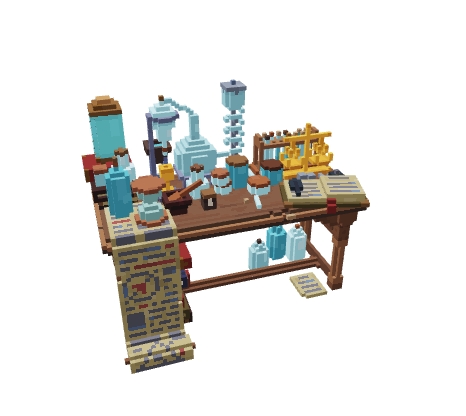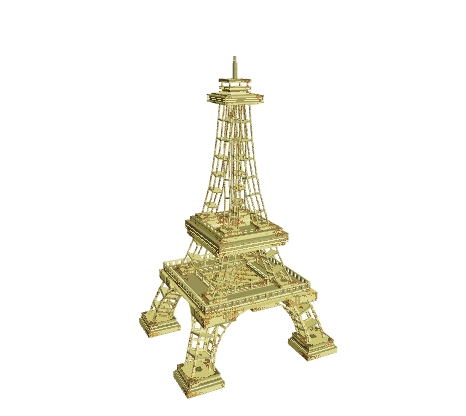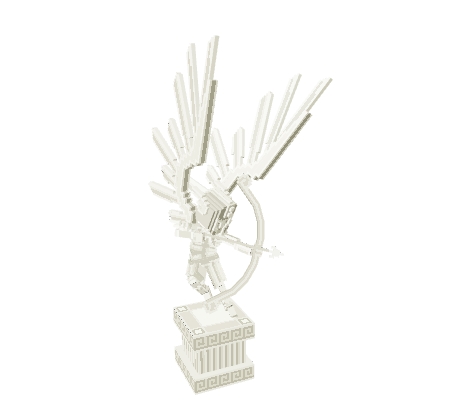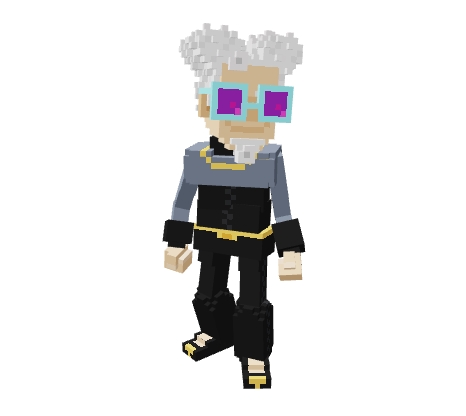Animator
Use the VoxEdit Animator to create Compound or Animated assets in The Sandbox.
Creating Compound & Animated Assets
Simple assets (models) are the pieces that make up compound and animated assets. Use the Animator to create static or animated assets with poses, or animations, and add motion if desired. Upload to use them in Game Maker.
Requirements
A structure, or skeleton
One or more poses, or animations
(Animated assets) motion applied to one or more animations
What Can I Make: Compound Assets
You can combine multiple models into a compound asset. It may have one or more poses of the models included, called animations. However, in compound assets, animations do not have motion (they are not animated).
Game Maker logic can dynamically display specific animations that are built into your asset, and it can change during the game.
Example
A fence could have normal and broken animations, where there's no movement, and the models are posed in different locations per animation.
Compound Assets
Compound assets are made in the Animator by combining simple assets (see Build a Rig).



In the Animator, simple assets are models that can be moved and rotated to design smoother details and shapes. A hierarchy, or Skeleton, controls how the models can move and rotate in relation to each other.

What Can I Make: Animated Assets
You can combine multiple models into a compound asset, set multiple poses (animations) of the models included, and apply motion keyframes for each one. Not all animations need to be animated).
Game Maker logic can dynamically display specific animations that are built into your asset, and it can change during the game.
Example
An NPC can wave hello until the player interacts. Then it can change to a talk animation while dialogue is displayed and change to an idle animation when the conversation is done.
Animated Assets
Once a compound asset is rigged together, you can create multiple animations (poses) and apply motion to each one with an easy timeline tool.


Templates have models, animations, and motion built in to create custom assets quickly. All you need to know is how to edit simple assets to make a new animated asset with a template.


How Do I Use My Creation?
Once your model is ready, you can upload it to your Workspace, create details to describe it, and give it attributes to define how it will be uniquely useful in The Sandbox Game. Then it's ready to test in Game Maker!
Getting Started
Animator Window
Tool Tips
↙️ Hover your mouse over anything in VoxEdit for tool tips at the bottom left.
Performance Data
↘️ See performance data at the bottom right (moved from the Viewport).
![]()
Dropdown Menu
⬆️ See Controls & Shortcuts for Dropdown Menu details.
Viewport
The Viewport is the central area of the screen where you can view and work on your project.
See Viewport Controls to learn how to:
Take a screenshot
Position your project
Adjust camera sensitivity
Change lighting and background colour

Panels
Menubar
The Menubar helps you save, translate, and visualize your project.

Controls
Save
Save
 CTRL+S
CTRL+S
Commit to changes. ℹ️ Use File -> Save As to save another version of your project.
Nodes
Select Node

Select nodes of your asset.
Move Node

Change the position of the selected node along the X, Y, or Z axis.
Rotate Node

Change the orientation of the selected node along the X, Y, or Z axis.
Translation
World

Set the world as the translation frame of reference.
Parent

Set the parent node as the translation frame of reference.
Object

Set the object as the translation frame of reference.
Transformation
Flip

Flip the entire asset along the X, Y, or Z axes.
AutoSLERP

Enable/disable AutoSLERP. Use this to automatically calculate in-between rotations for smoother, constant speed.
Align to Axis

Reset scene transformations. This aligns the rig to the closest axis at a right angle.
Visualization
Show/Hide Rig

Toggle the visibility of the rig skeletons. This shows/hides connections between nodes, with lines that are thicker at the parent node and thinner at the child node.
Model Check

Toggle a mode with high contrast colours to check for quality issues, such as Clipping or Z-fighting.
Show/Hide Node Bounding Boxes

Toggle visibility of the node bounding boxes. This helps visualise collisions of each model attached to nodes in your rig. Trim the volume if a node's collision box is larger than the linked model.
Emissivity

Toggle brightness of glowing colours with bloom. When disabled, the glow from emissive colours used in your rig's models will not be visible.
Focus (Reset View)
 F
F
Focus the camera to the default start position.
Library
The Library stores all of the simple models you've imported or created for your asset. You can import .VXM files (made in VoxEdit) or .VOX files (made in other programs like MagicaVoxel).

Controls: Main
 Trim
Trim
Trim volumes of selected models to optimize colliders.
 Edit
Edit
Edit the selected model (no asset ghost).
 Duplicate
Duplicate
Add a copy of selected models to the Library.
 Delete
Delete
Remove selected models from the Library.
Duplicate models to vary parts in your asset. Duplicate and flip a model for mirrored symmetry (e.g., arms).
![]() Menu
Menu
New VXM
Add a new empty model to the Library.
Import VXM
Import a model from another project.
Import VOX
Import a 3D voxel file made in another program, such as MagicaVoxel.
Delete Unattached
Remove all models from the Library that are not linked a node.
Delete Backup Models
Declutter your Library if backup models are not needed.
Trim Volume
Edit Model
Duplicate Model
Delete Model
To edit with the asset's ghost shown, click the  edit button next to the node in the Skeleton.
edit button next to the node in the Skeleton.
SELECT MULTIPLE MODELS (LIBRARY or VIEWPORT)
Add or remove individual models: Hold the CTRL key as you click on each model.
Select a range of models: Hold the SHIFT key as you select the first and last models in a group.
Controls: Right Click a Model
Duplicate Model
Rename Model
Edit a model's name.
Replace Model
Use a different model in your files (affects the rig if linked).
Export as VOX
Save the model in .VOX format for use in programs such as MagicaVoxel.
Delete Model
Link a Model to a Node
Drag and drop a model onto the correct node in the Viewport.
Open the menu for the correct node in the Skeleton for the Link VXM option.
Skeleton
The Skeleton displays the structure of your compound or animated asset's rig. It is a hierarchy of how the pieces of your asset fit together and are allowed to be moved.
Each item in the skeleton is a node. Models may be linked to nodes, giving the rig shape in the Viewport.
Learn more: Build a Rig

Node Controls
If a node has child nodes (and influences their position and rotation), these controls appear on the left.
A child node is ![]() indented below a parent node to show its depth in the hierarchy.
The
indented below a parent node to show its depth in the hierarchy.
The ![]() World node is the root node for your project.
World node is the root node for your project.
![]() Expand Node
Expand Node
View the node's child nodes.
![]() Collapse Node
Collapse Node
Hide the node's child nodes.
 Menu Controls
Menu Controls
Open a node's menu to make changes related to that node and/or its child nodes.
Create a Child Node
Add a node that will be controlled by the position and rotation of this node.
Duplicate Node
Duplicate this node on the same level. The copy will have the same parent node.
Rename Node
Change the name of the node with up to 24 characters. No nodes may have the same name.
Select Hierarchy
Select the node and all nodes beneath it in the hierarchy.
Export Hierarchy
Save this node and all nodes beneath it in the hierarchy as a separate project.
Import Hierarchy (VXR, VOX)
Import the node structure of another project beneath this node.
Link/Unlink VXM from Node
Attach a model to this node or unattach a model from it. ℹ️ You can also drag and drop a model from the Library onto a node in the Viewport.
Delete Node
Remove the node and all nodes beneath it in the hierarchy (its child nodes, their child notes, etc).
Inspector
The Inspector allows you have more granular control of a node's position and rotation by entering a value. You can also toggle collisions on or off for one or more selected nodes.

Timeline
The Timeline allows you to add motion keyframes to an animation, or pose, of your asset.

Animations List (Poses)
The Animations List includes all poses built in your asset. Motion may or may not be applied to each. A search makes finding animations fast for assets that have many.

Controls
 New Animation
New Animation
Add a new animation to the list (duplicates the selected animation).
 Import Animation
Import Animation
If rigs are compatible, you may import an animation from another project.
 Clean Animations
Clean Animations
Remove all animations except the selected ones.
OPTIMISE YOUR WORKFLOW
Create a new animation when the nodes in the Viewport match (or are close to) the starting positions and rotations needed for the new animation. This avoids repositioning, saving you a lot of time!
![]() Menu
Menu
Set as Default
Duplicate Animation
Rename Animation
Export Animation
Delete Animation
Advanced: Inverse Kinematics (Hidden)
Inverse Kinematics is a hidden panel for advanced users to create more realistic movements and set poses, or animations, more quickly. You can find it in the View menu at the top of the screen.
Learn more: Use Inverse Kinematics

Controls
Enable IK
Enabled - Adjusting the position or rotation of a child node influences the position and rotation of the parents it is attached to.
Disabled - The parent-child relationship behaves normally, where a parent node influences all of the child nodes attached to it (known as Forward Kinematics, or FK).
Anchor
IK Controller
Constraints
Roll Start: Size:
 Add
Add
Yaw Pitch Radius
Last updated
Was this helpful?






















